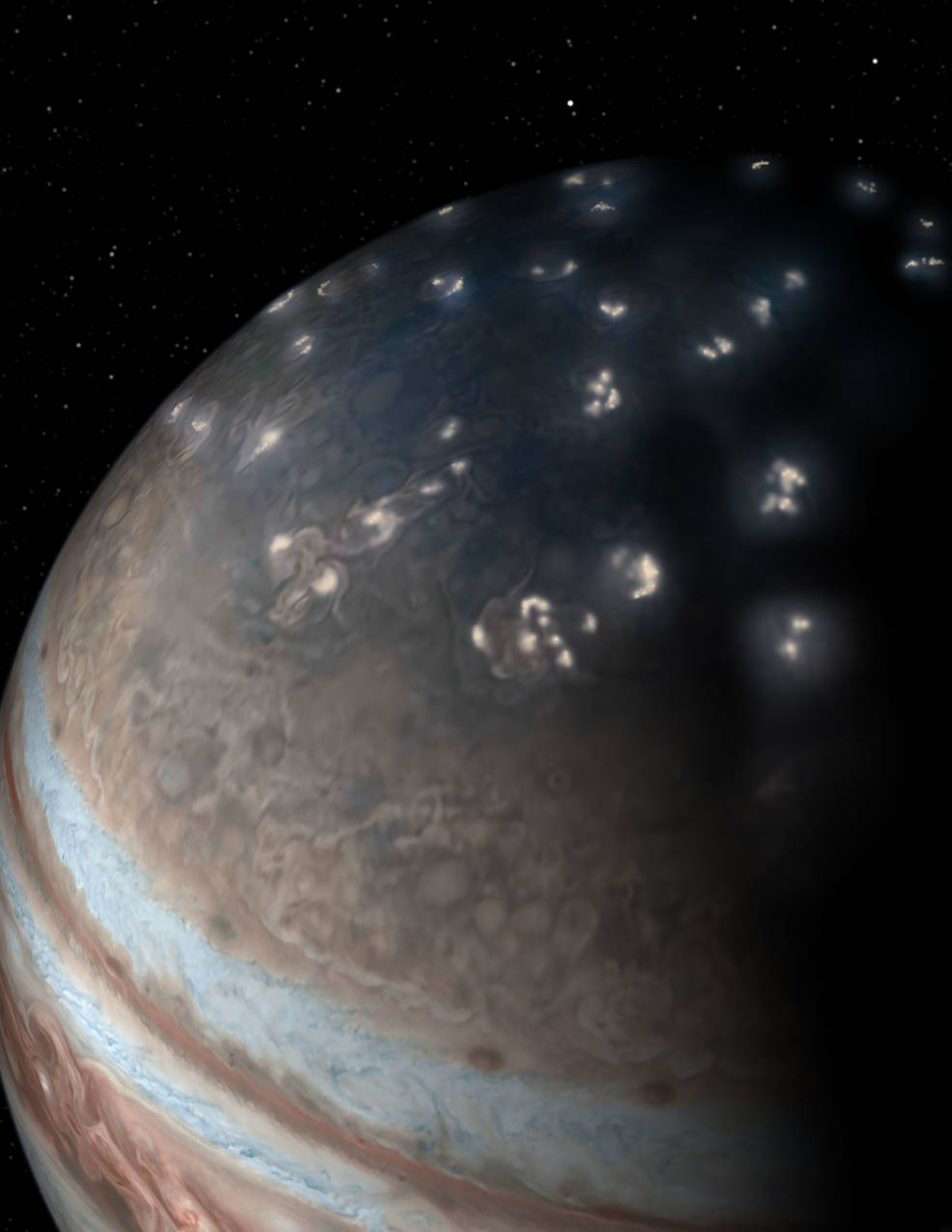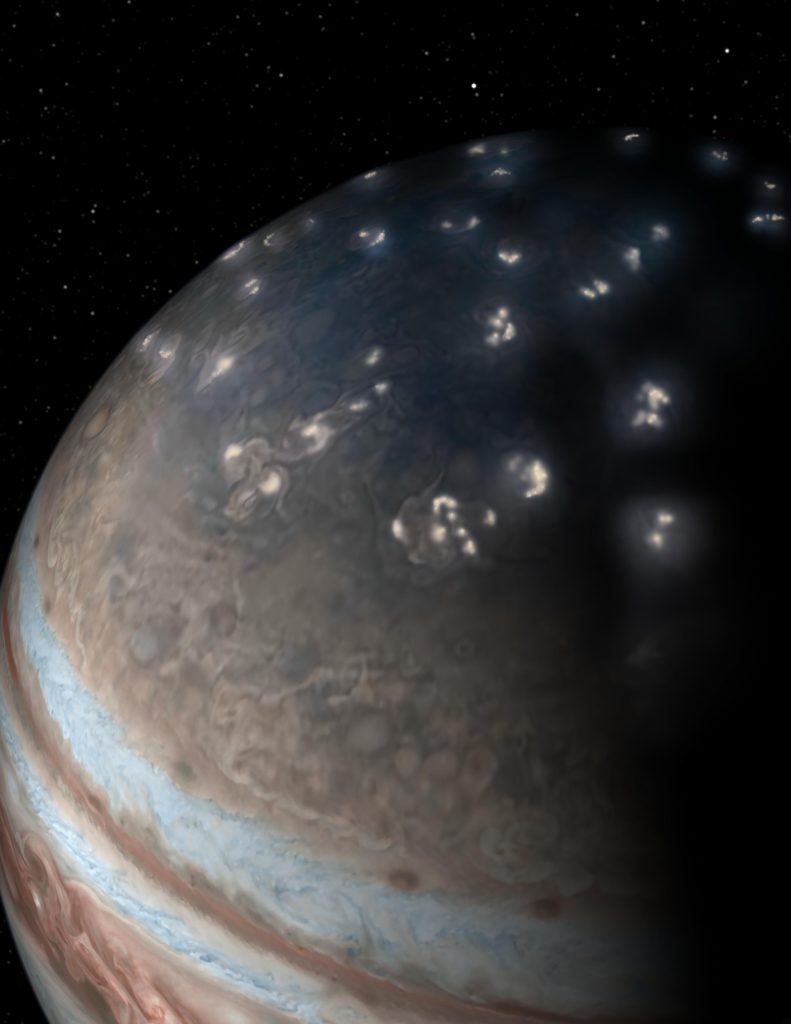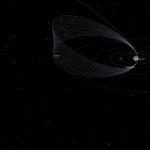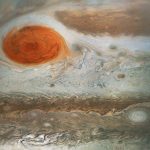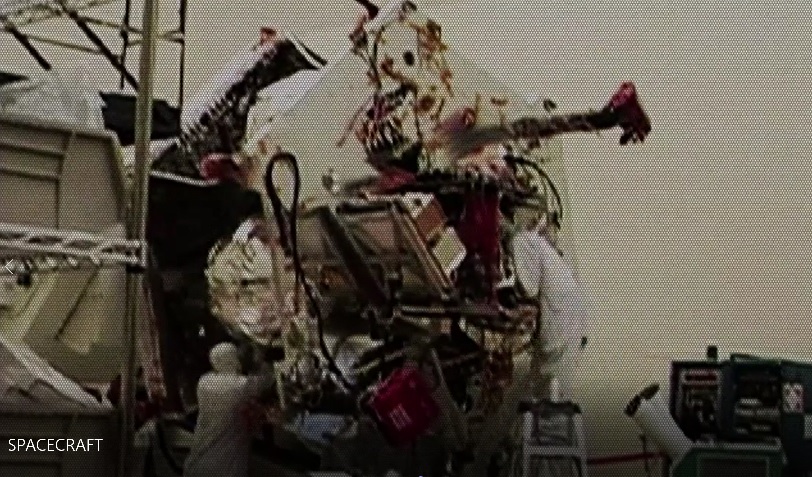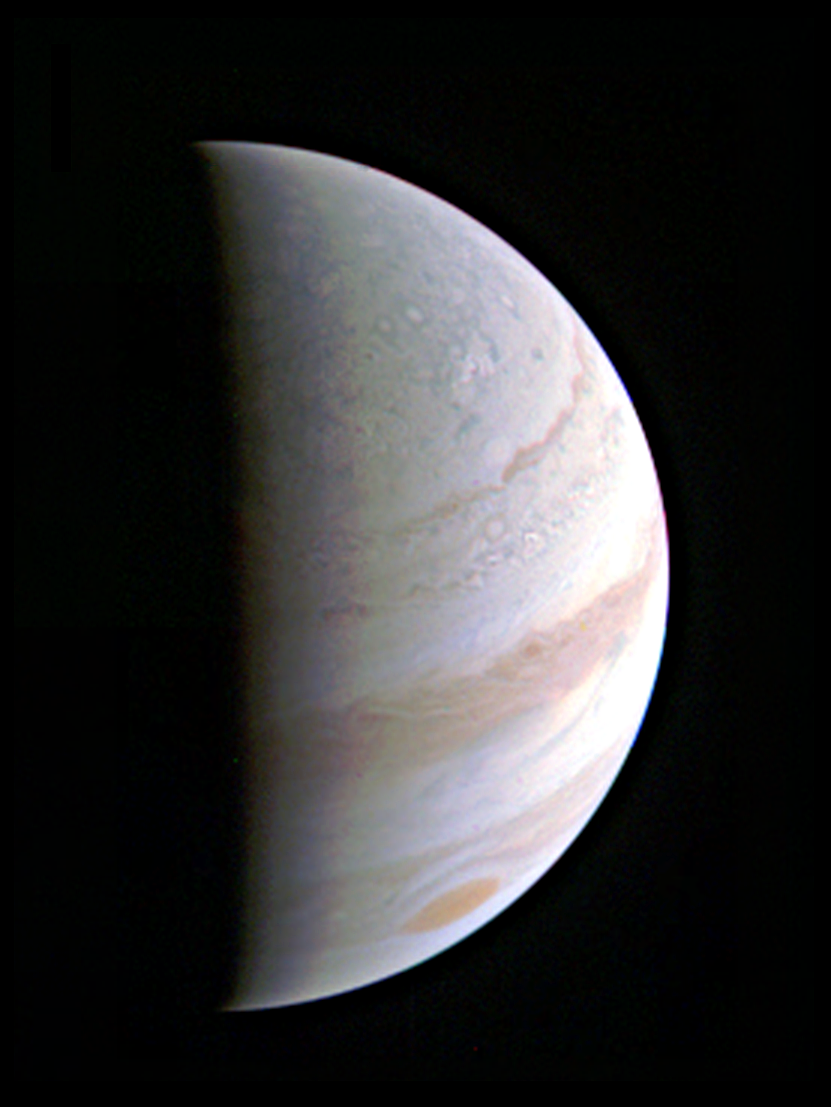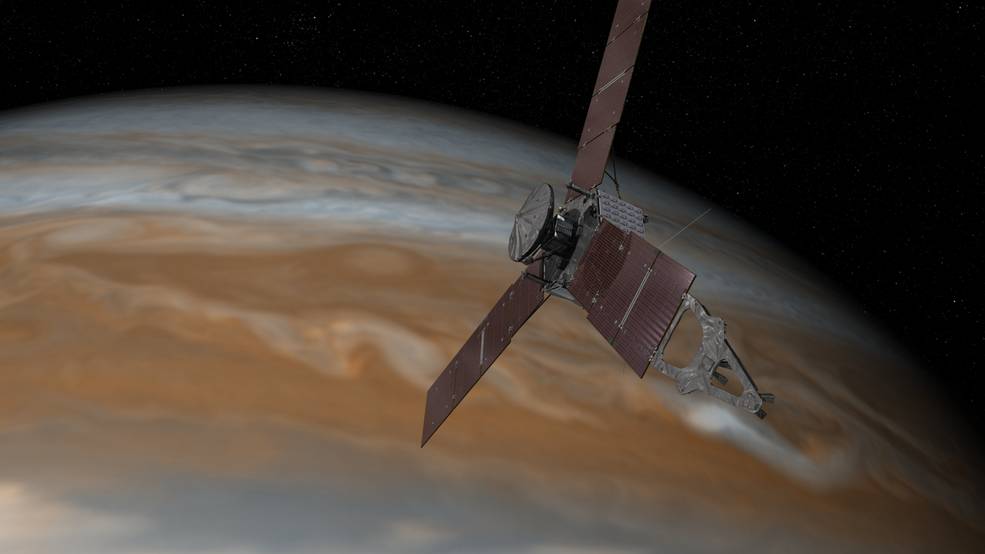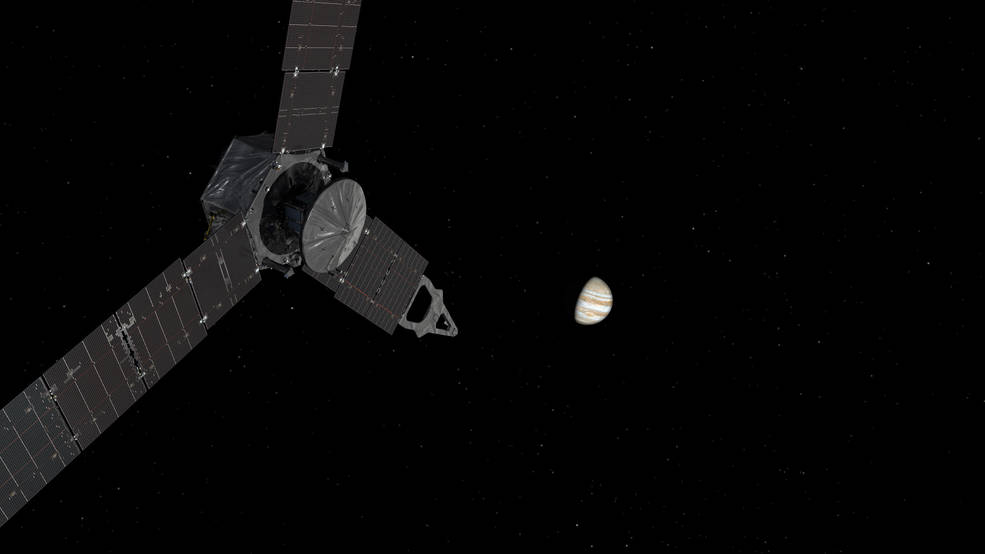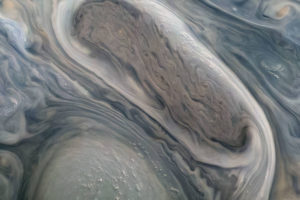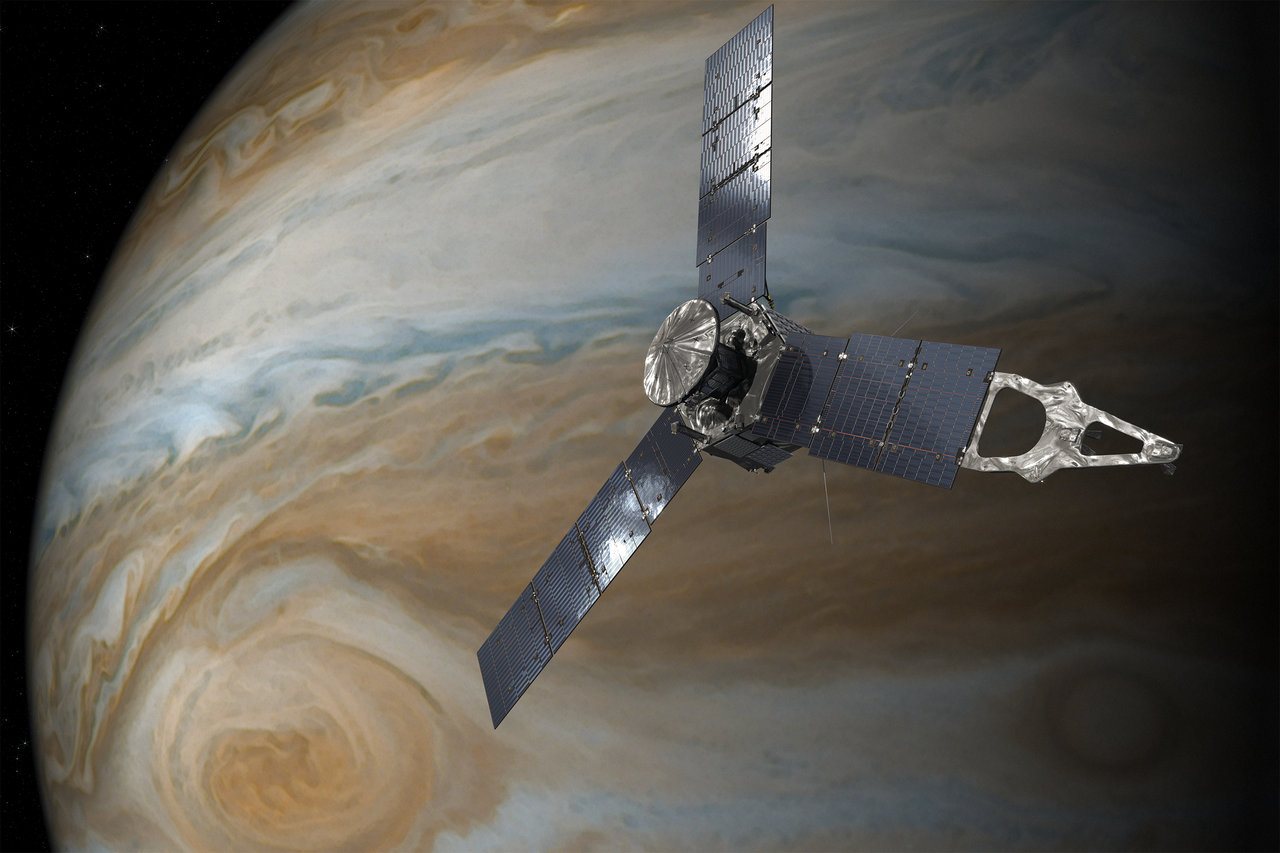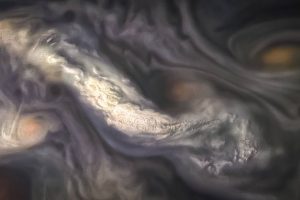最高解像度のオリジナル画像
NASAのオリジナル記事と和訳
Ever since NASA’s Voyager 1 spacecraft flew past Jupiter in March, 1979, scientists have wondered about the origin of Jupiter’s lightning. That encounter confirmed the existence of Jovian lightning, which had been theorized for centuries. But when the venerable explorer hurtled by, the data showed that the lightning-associated radio signals didn’t match the details of the radio signals produced by lightning here at Earth.
1979年3月にNASAの木星探査機Voyager 1号が木星を通過した際に科学者たちは木星の雷が発生するメカニズムを解明できずに謎のまま現在に至っています。木星の稲妻の存在を確認はしても、理論的に解明することができなかったのです。ところが老朽化し探査機に雷が落ちた際に、稲妻の発する放射電波が地球上の雷による電波と一致しないことがわかったのです。
In a new paper published in Nature today, scientists from NASA’s Juno mission describe the ways in which lightning on Jupiter is actually analogous to Earth’s lightning. Although, in some ways, the two types of lightning are polar opposites.
本日発刊の科学雑誌ネイチャーに掲載された新しい論文では、NASAのジュノーミッションの科学者が、木星の雷と地球の雷の類似点について記載しています。しかしいくつかの点で木星と地球の雷は逆の極性を持っています。
“No matter what planet you’re on, lightning bolts act like radio transmitters — sending out radio waves when they flash across a sky,” said Shannon Brown of NASA’s Jet Propulsion Laboratory in Pasadena, California, a Juno scientist and lead author of the paper. “But until Juno, all the lightning signals recorded by spacecraft [Voyagers 1 and 2, Galileo, Cassini] were limited to either visual detections or from the kilohertz range of the radio spectrum, despite a search for signals in the megahertz range. Many theories were offered up to explain it, but no one theory could ever get traction as the answer.”
ネイチャー誌への寄稿者でもあり、カリフォルニア州パサデナにあるNASAのJPLのシャノン・ブラウン氏は「どんな惑星の雷であっても、ラジオ放送局のように空中を伝播する電波を発信するものです。」と語りました。「しかし、探査機ジュノー以前では、探査機(Voyagers 1号と2号、ガリレオ、カッシーニ)で記録されたすべての雷の信号は、メガヘルツの範囲の信号を受信していたにもかかわらず、画像や電波で記録したのはキロヘルツ範囲に制限されていました。木星の雷を説明しようとする多くの理論が提出されましたが、いずれの理論も正解とする根拠を得ることができませんでした。
Enter Juno, which has been orbiting Jupiter since July 4, 2016. Among its suite of highly sensitive instruments is the Microwave Radiometer Instrument (MWR), which records emissions from the gas giant across a wide spectrum of frequencies.
2016年7月4日からジュノーは木星の周回軌道に入ることができています。ジュノーには非常に高感度の観測機器であるMWR(Microwave Radiometer Instrument)が搭載されています。
“In the data from our first eight flybys, Juno’s MWR detected 377 lightning discharges,” said Brown. “They were recorded in the megahertz as well as gigahertz range, which is what you can find with terrestrial lightning emissions. We think the reason we are the only ones who can see it is because Juno is flying closer to the lighting than ever before, and we are searching at a radio frequency that passes easily through Jupiter’s ionosphere.”
「すでに8回にわたる木星最接近時のデータからみるとジュノーのMWRは377回の雷放電を検出しています。 “これらの雷はメガヘルツとギガヘルツの周波数帯で記録されていました。これは地球上の雷放射によって観測されるものと同じです。その理由としては今のところ一つしかなく、それはジュノーがこれまで以上に木星に近づき木星の電離層を容易に通過してくる周波数を受信しているからです。
While the revelation showed how Jupiter lightning is similar to Earth’s, the new paper also notes that where these lightning bolts flash on each planet is actually quite different.
この観測結果は木星の雷が地球とどのように似ているかを示していますが、この新しい論文では、雷の発生する電圧は木星と地球とでは全く異なっていることを明らかにしています。
“Jupiter lightning distribution is inside out relative to Earth,” said Brown. “There is a lot of activity near Jupiter’s poles but none near the equator. You can ask anybody who lives in the tropics — this doesn’t hold true for our planet.”
「木星の雷の分布は地球に比べると内側にあります。」とブラウン氏は語ります。 「木星の極の近傍では多くの雷が生じていますが赤道の近くには雷は見当たりません。これは熱帯地方に住んでいる誰に聞いてもわかることです – これは私たちの地球では違っています。」
Why do lightning bolts congregate near the equator on Earth and near the poles on Jupiter? Follow the heat.
ではなぜ地球では赤道近くに稲妻が多く、木星では極の近くに多くなっているのでしょうか?熱について考えてみてください。
Earth’s derives the vast majority of its heat externally from solar radiation, courtesy of our Sun. Because our equator bears the brunt of this sunshine, warm moist air rises (through convection) more freely there, which fuels towering thunderstorms that produce lightning.
地球は太陽が放射する熱の大部分を外部に放出しています。地球の赤道付近では太陽光が温度上昇を引き起こしているので、暖かい湿った空気がそこでより自由に(対流をおこして)上昇し、稲妻を産む嵐産み出し成長させています。
Jupiter’s orbit is five times farther from the Sun than Earth’s orbit, which means that the giant planet receives 25 times less sunlight than Earth. But even though Jupiter’s atmosphere derives the majority of its heat from within the planet itself, this doesn’t render the Sun’s rays irrelevant. They do provide some warmth, heating up Jupiter’s equator more than the poles — just as they heat up Earth. Scientists believe that this heating at Jupiter’s equator is just enough to create stability in the upper atmosphere, inhibiting the rise of warm air from within. The poles, which do not have this upper-level warmth and therefore no atmospheric stability, allow warm gases from Jupiter’s interior to rise, driving convection and therefore creating the ingredients for lightning.
木星の軌道は地球の軌道より太陽から5倍離れているため、巨大な惑星である木星でも受ける太陽光は地球の25分の1しかありません。しかし木星の大気は、木星自体の内部から大部分の熱を受けているので太陽の陽の光の過多は問題となりません。惑星内部の熱は惑星を暖かくするので、木星の赤道付近の方が極付近よりも暖かくするのは地球と同じです。科学者たちは木星の赤道でのこの暖房効果が大気中の温かい空気の上昇を抑えて、木星大気上層部での安定性を生み出していると考えています。この大気上層の暖かさを持たず、したがって大気の安定性がない木星の極では、木星の内部からの温かいガスが上昇し対流を引き起こすので、雷の成分を作り出していると考えています。
“These findings could help to improve our understanding of the composition, circulation and energy flows on Jupiter,” said Brown. But another question looms. “Even though we see lightning near both poles, why is it mostly recorded at Jupiter’s north pole?”
「これらの発見は、木星の組成、循環、エネルギーの流れの理解を向上させるのに役立つだろう。」とブラウンは言います。「しかし別の問題が生じてきます。両極の近傍で雷が見えているのですが、主に木星の北極に集中して記録されるのはなぜでしょうか?」
In a second Juno lightning paper published today in Nature Astronomy, Ivana Kolmašová of the Czech Academy of Sciences, Prague, and colleagues, present the largest database of lightning-generated low-frequency radio emissions around Jupiter (whistlers) to date. The data set of more than 1,600 signals, collected by Juno’s Waves instrument, is almost 10 times the number recorded by Voyager 1. Juno detected peak rates of four lightning strikes per second (similar to the rates observed in thunderstorms on Earth) which is six times higher than the peak values detected by Voyager 1.
科学雑誌ネイチャーで今日公開された2つ目の論文では、プラハのチェコ科学アカデミーのIvanaKolmašováらは、これまでに木星(ホイッスラー)の周りで発生した最大の雷の低周波電波放射のデータベースを提示しています。 ジュノー観測器で収集された1,600以上の信号のデータは、Voyager 1号によって記録された数の約10倍にもなります。ジュノーは、1秒あたり4回の落雷のピークレート(地球上の雷雨で観測されたレートと同様)であり、 Voyager 1号で検出されたピーク値よりも6倍高精度になります。
“These discoveries could only happen with Juno,” said Scott Bolton, principal investigator of Juno from the Southwest Research Institute, San Antonio. “Our unique orbit allows our spacecraft to fly closer to Jupiter than any other spacecraft in history, so the signal strength of what the planet is radiating out is a thousand times stronger. Also, our microwave and plasma wave instruments are state-of-the-art, allowing us to pick out even weak lightning signals from the cacophony of radio emissions from Jupiter. “
「これらの発見はジュノーだからできたのです。」とサン・アントニオのSouthwest Research Instituteのジュノー主任研究員Scott Bolton氏は語りました。 「私たちの探査機ジュノーの軌道は、歴史上他のどの探査機よりも木星に近づくことを可能にするので、木星が放射している信号強度は千倍強く受信することができます。また、私たちのマイクロ波やプラズマ波の観測機器は、最先端の技術であり、木星からの電波放射の微弱な稲妻信号でも取り出すことができます。 」
NASA’s Juno spacecraft will make its 13th science flyby over Jupiter’s mysterious cloud tops on July 16.
NASAの木星探査機ジュノーは、7月16日に木星の神秘的な雲頂に最接近して13回目の科学観測を行います。
NASA’s Jet Propulsion Laboratory, Pasadena, California, manages the Juno mission for the principal investigator, Scott Bolton, of the Southwest Research Institute in San Antonio. Juno is part of NASA’s New Frontiers Program, which is managed at NASA’s Marshall Space Flight Center in Huntsville, Alabama, for NASA’s Science Mission Directorate. The Microwave Radiometer instrument (MWR) was built by JPL. The Juno Waves instrument was provided by the University of Iowa. Lockheed Martin Space, Denver, built the spacecraft.
More information on Juno can be found at:https://www.nasa.gov/juno、https://www.missionjuno.swri.edu
More information about Jupiter can be found at:https://www.nasa.gov/jupiter
The public can follow the mission on Facebook and Twitter at:https://www.facebook.com/NASAJuno、https://www.twitter.com/NASAJuno
DC Agle
Jet Propulsion Laboratory, Pasadena, Calif.
818-393-9011
agle@jpl.nasa.gov
JoAnna Wendel
NASA Headquarters, Washington
202-358-1003
joanna.r.wendel@nasa.gov
Richard Lewis
University of Iowa, Iowa City
319-384-0012
richard-c-lewis@uiowa.edu
Deb Schmid
Southwest Research Institute, San Antonio
210-522-2254
dschmid@swri.org
2018-128
